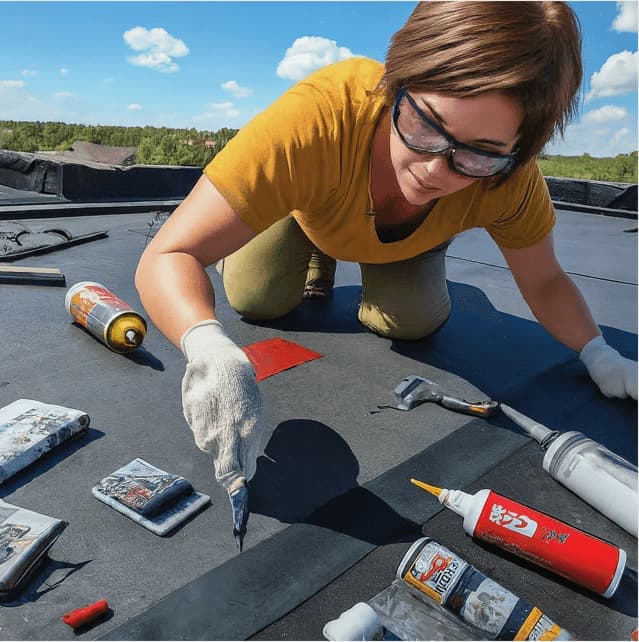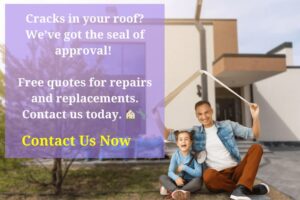Repair
Rubber Roof Repair – A Comprehensive Guide
Rubber roofing, formally known as Ethylene Propylene Diene Terpolymer (EPDM) roofing, stands out as a durable and cost-effective solution for both commercial and residential properties.
EPDM roofs are crafted from a synthetic rubber membrane, renowned for its exceptional weather resistance, flexibility, and longevity.
EPDM roofing has gained widespread popularity due to its ability to withstand harsh weather conditions, including extreme temperatures, UV exposure, and high winds.
Unlike traditional roofing materials such as asphalt or metal, EPDM roofing offers superior resistance to cracking, blistering, and peeling, making it an ideal choice for regions prone to temperature fluctuations and inclement weather.
1.1. The Benefits of EPDM Roofing:
- Durability:
EPDM roofing boasts exceptional durability, with a typical lifespan ranging from 25 to 30 years.
Its robust construction ensures long-term protection against weather-related damage and environmental wear and tear.
-
Cost-Effectiveness:
Compared to other roofing materials, EPDM roofing offers excellent value for money.
Its relatively low installation and maintenance costs make it an attractive option for budget-conscious property owners.
-
Versatility:
EPDM roofing is highly versatile and can be installed on a variety of roof structures, including flat roofs and low-slope roofs.
Its flexibility allows for easy customization to fit the unique dimensions and contours of different buildings.
-
Energy Efficiency:
EPDM roofing contributes to energy efficiency by reflecting sunlight and reducing heat absorption.
This reflective property helps maintain a comfortable indoor temperature and may lead to lower cooling costs during hot summer months.
-
Ease of Installation:
EPDM roofing is relatively easy to install, especially when compared to traditional roofing materials.
Its lightweight nature and flexible membrane facilitate quick and hassle-free installation, minimizing disruptions to daily operations for commercial properties.
1.2. Rubber Roof Coatings for Repairs and Protection:
Rubber roof coatings offer a versatile and effective solution for repairing minor damage and providing added protection to rubber roofing systems.
These coatings are specially formulated to adhere to rubber membranes, forming a seamless barrier that shields the roof from moisture infiltration, UV radiation, and environmental contaminants.
In this section, we’ll explore the benefits of rubber roof coatings and their role in enhancing the durability and performance of your rubber roof.
1.3. Benefits of Rubber Roof Coatings:
- Seamless Protection:
Rubber roof coatings create a seamless, waterproof barrier that prevents water penetration and protects the underlying roofing materials from damage.
By sealing cracks, seams, and other vulnerable areas, these coatings help maintain the integrity of the roof and extend its lifespan.
-
UV Resistance:
Rubber roof coatings contain UV-resistant additives that shield the roof from the damaging effects of sunlight.
By reflecting UV rays and reducing heat absorption, these coatings help prevent premature aging, discoloration, and deterioration of the rubber membrane.
-
Enhanced Durability:
Applying a rubber roof coating adds an extra layer of protection to the roofing system, enhancing its durability and resistance to wear and tear.
This can help mitigate issues such as punctures, abrasions, and membrane damage, prolonging the roof’s life and reducing the need for repairs.
-
Energy Efficiency:
Some rubber roof coatings are formulated with reflective properties that help reduce heat buildup on the roof’s surface.
By reflecting sunlight and reducing thermal transfer into the building, these coatings can lower indoor temperatures and decrease cooling costs, leading to potential energy savings.
- Easy Application:
Rubber roof coatings are typically easy to apply, requiring minimal preparation and equipment.
Whether applied with a brush, roller, or sprayer, these coatings can be quickly and efficiently installed by DIY enthusiasts or professional contractors, depending on the scope of the project.
2. Importance of Regular Roof Inspections:
Regular roof inspections are the cornerstone of proactive maintenance for rubber roofs, offering property owners invaluable insights into the condition of their roofing system.
Whether you own a commercial building or a residential property, scheduling routine roof inspections is essential for identifying potential issues early on and mitigating the risk of costly repairs down the line.
The Benefits of Regular Roof Inspections:
-
Early Detection of Issues:
Routine roof inspections allow trained professionals to identify signs of damage or deterioration before they escalate into major problems.
From small leaks and punctures to signs of wear and tear, early detection enables prompt intervention and minimizes the risk of extensive damage to the roofing system and underlying structures.
- Prolonged Lifespan of the Roof:
By addressing minor issues promptly and conducting proactive maintenance, regular roof inspections can extend the lifespan of your rubber roof.
Timely repairs and preventive measures help preserve the integrity of the roofing membrane, ensuring optimal performance and longevity for years to come.
- Protection Against Costly Repairs:
Neglecting roof maintenance can lead to costly repairs and structural damage. Regular inspections enable property owners to identify issues early on.
Allowing for timely repairs and preventing minor problems from escalating into major repair projects that require significant time and financial investment.
- Compliance with Warranty Requirements:
Many roofing warranties require property owners to perform regular inspections and maintenance to remain valid.
By adhering to warranty requirements and keeping detailed records of roof inspections and repairs, property owners can safeguard their investments and avoid potential disputes with manufacturers or warranty providers.
- Enhanced Property Value:
A well-maintained roof enhances the overall value and curb appeal of a property. Regular roof inspections demonstrate diligence and proactive maintenance to potential buyers or tenants.
Instilling confidence in the property’s structural integrity and minimizing concerns about future maintenance expenses.
2.1. Roof Replacement vs. Rubber Roof Repair:
When confronted with significant damage or wear to a rubber roof, property owners are faced with the crucial decision of whether to repair the existing roof or opt for a complete roof replacement.
This decision requires careful consideration of various factors, ranging from the extent of damage to long-term financial implications.
Let’s delve deeper into these considerations to empower property owners to make informed choices regarding their roofing needs.
Factors to Consider:
-
The extent of Damage:
Assess the severity and spread of damage to the rubber roof. Minor issues like isolated leaks or superficial damage may be effectively addressed through repair.
Conversely, extensive damage compromising structural integrity may necessitate roof replacement to ensure long-term stability.
- Overall Condition of the Roof:
Evaluate the roof’s general state, taking into account its age, maintenance history, and previous repairs.
A relatively young roof exhibiting minor issues may warrant repair, whereas an aging roof with multiple issues might benefit from replacement to avoid recurring problems.
- Financial Considerations:
Consider the budget implications of both repair and replacement options. While roof repair typically involves lower upfront costs, recurrent repairs over time may accumulate expenses.
In contrast, roof replacement entails a higher initial investment but offers long-term savings by providing a durable, low-maintenance solution.
- Long-Term Goals:
Align the decision with your property’s long-term objectives. If you plan to sell or lease the property soon, investing in roof replacement may enhance its market value and appeal to prospective buyers or tenants.
Conversely, if you intend to stay in the property, prioritize durability and longevity to minimize future maintenance costs.
Affiliate Link Plug: For property owners seeking professional roof inspection services, we recommend “Remodel your home” to a reputable roofing inspection service provider] for comprehensive inspections and expert guidance.
3. DIY vs. Professional Rubber Roof Repairs:
When faced with rubber roof repairs, property owners often find themselves at a crossroads, weighing the option of tackling repairs themselves or enlisting the expertise of professional roofing contractors.
While both approaches have their merits, it’s essential to consider various factors to make an informed decision that ensures optimal outcomes and long-term satisfaction.
Factors to Consider:
-
Scope of Repairs:
Assess the extent and complexity of the repairs needed. Minor issues such as patching small leaks or applying sealants may be suitable for DIY repairs.
More extensive damage or structural issues require the skills and experience of professionals.
-
Safety Considerations:
Roof repairs can be hazardous, especially for inexperienced individuals. Working at heights and handling roofing materials pose risks of falls, injuries, and accidents.
Professional roofers are trained in safety protocols and have the necessary equipment to perform repairs safely and effectively.
-
Quality of Workmanship:
Professional roofing contractors bring expertise, craftsmanship, and industry knowledge to the table.
Their experience allows them to diagnose issues accurately, recommend appropriate solutions, and execute repairs with precision, ensuring quality workmanship and long-lasting results.
-
Time and Convenience:
DIY repairs require time, effort, and resources to research, plan, and execute. Professional roofing contractors streamline the repair process, saving property owners time and hassle.
Additionally, hiring professionals minimizes disruptions to daily routines and ensures the timely completion of repairs.
-
Cost Considerations:
While DIY repairs may seem cost-effective upfront, they can result in additional expenses if not done correctly.
Mistakes or inadequate repairs may lead to further damage, necessitating costly repairs or even roof replacement.
Professional roofing services offer competitive pricing and provide value in terms of quality, durability, and peace of mind.
3.1. DIY vs. Professional Roof Repair Decision Matrix:
|
Factors |
DIY Repair | Professional Repair |
| Scope of Repairs | Suitable for minor issues | Suitable for extensive damage or structural issues |
| Safety Considerations | DIYers may lack proper safety equipment | Professionals adhere to safety protocols |
| Quality of Workmanship | Limited expertise and craftsmanship | Professional expertise and industry knowledge |
| Time and Convenience | Requires time and effort for research and execution | Streamlined process with minimal disruption |
| Cost Considerations | Lower upfront costs but may lead to additional expenses | Competitive pricing with quality assurance |
For property owners seeking professional roofing services, we recommend “Remodel your home” a reputable roofing contractor for reliable and skilled contractors.
3.2. Regulatory Compliance and Sustainability:
Rubber roofing systems, particularly those made from EPDM (Ethylene Propylene Diene Terpolymer), offer various environmental and regulatory compliance benefits.
EPDM membranes are often manufactured using eco-friendly processes and materials, making them a sustainable roofing option.
Additionally, EPDM roofing systems may contribute to energy efficiency, reducing heating and cooling costs for buildings.
Key Points:
1. Energy Efficiency: EPDM roofing membranes can help improve a building’s energy efficiency by reducing heat transfer and lowering cooling costs during hot weather.
2. Sustainability: EPDM roofing materials are recyclable and may contain recycled content, reducing the environmental impact associated with roof replacement projects.
3. Durability: EPDM roofing systems have a long lifespan, reducing the need for frequent replacements and minimizing waste.
4. Regulatory Compliance: EPDM roofing systems may comply with various building codes and environmental regulations, ensuring that properties meet sustainability standards and safety requirements.
Note:
The decision between DIY and professional rubber roof repairs hinges on various factors, including the scope of repairs, safety considerations, quality of workmanship, time, convenience, and cost.
While DIY repairs may be suitable for minor issues and budget-conscious property owners, professional roofing services offer expertise, safety assurances, and peace of mind for more complex repairs.
By weighing these factors carefully and considering the specific needs of their roofing project, property owners can make informed decisions that ensure optimal outcomes and long-term satisfaction.
4. Identifying Common Issues with Rubber Roofs: A Closer Look
Rubber roofs, while durable and long-lasting, are not immune to wear and tear over time.
Identifying common issues early on is crucial for maintaining the integrity of the roofing system and preventing costly repairs or replacements.
Let’s delve deeper into some of the most prevalent issues that property owners may encounter with rubber roofs:
4.1. Leaks and Punctures:
Leaks are one of the most common issues with rubber roofs, often caused by punctures from sharp objects, debris, or foot traffic.
Identifying leaks early is essential to prevent water damage to the roof structure and interior of the building.
4.2. Shrinkage and Blistering:
Rubber roofs may experience shrinkage over time due to exposure to UV radiation, extreme temperatures, or poor installation.
Blistering occurs when air or moisture becomes trapped between the rubber membrane and the substrate, leading to raised bubbles or blisters on the surface of the roof.
4.3. Ponding Water:
Ponding water occurs when water accumulates and pools on the surface of the roof, often due to inadequate drainage or improper installation.
Prolonged ponding water can lead to deterioration of the rubber membrane, structural damage, and mold or mildew growth.
4.4. Membrane Damage:
Damage to the rubber membrane can occur due to factors such as hail, fallen branches, or mechanical abrasion during maintenance activities.
Inspecting the membrane for tears, cuts, or abrasions is essential for identifying potential vulnerabilities and preventing water infiltration.
4.5. Poor Installation or Repairs:
Improper installation or substandard repairs can compromise the integrity of the rubber roof, leading to premature failure and costly repairs.
Hiring qualified roofing professionals for installation and repairs ensures adherence to industry standards and best practices, minimizing the risk of issues arising from poor workmanship.
4.6. UV Degradation:
Exposure to UV radiation can cause rubber roofing materials to degrade over time, leading to discoloration, brittleness, and reduced flexibility.
Applying UV-resistant coatings or protective sealants can help mitigate the effects of UV degradation and extend the lifespan of the rubber roof.
5. Rubber Roof Coatings for Repairs and Protection:
Rubber roof coatings offer a versatile and effective solution for repairing minor damage and providing added protection to rubber roofing systems.
These coatings are specially formulated to adhere to rubber membranes, forming a seamless barrier that shields the roof from moisture infiltration, UV radiation, and environmental contaminants.
In this section, we’ll delve deeper into the benefits of rubber roof coatings and how they can contribute to the longevity and performance of your rubber roof.
Benefits of Rubber Roof Coatings:
-
Seamless Protection:
Rubber roof coatings create a seamless, waterproof barrier that prevents water penetration and protects the underlying roofing materials from damage.
By sealing cracks, seams, and other vulnerable areas, these coatings help maintain the integrity of the roof and extend its lifespan.
- UV Resistance:
Rubber roof coatings contain UV-resistant additives that shield the roof from the damaging effects of sunlight, by reflecting UV rays and reducing heat absorption.
These coatings help prevent premature aging, discoloration, and deterioration of the rubber membrane.
- Enhanced Durability:
Applying a rubber roof coating adds an extra layer of protection to the roofing system, enhancing its durability and resistance to wear and tear.
This can help mitigate issues such as punctures, abrasions, and membrane damage, prolonging the roof’s life and reducing the need for repairs.
- Energy Efficiency:
Some rubber roof coatings are formulated with reflective properties that help reduce heat buildup on the roof’s surface. By reflecting sunlight and reducing thermal transfer into the building.
These coatings can lower indoor temperatures and decrease cooling costs, leading to potential energy savings.
- Easy Application:
Rubber roof coatings are typically easy to apply, requiring minimal preparation and equipment.
Whether applied with a brush, roller, or sprayer, these coatings can be quickly and efficiently installed by DIY enthusiasts or professional contractors, depending on the scope of the project.
6. Roof Replacement vs. Rubber Roof Repair:
When confronted with significant damage or wear to a rubber roof, property owners are faced with the crucial decision of whether to repair the existing roof or opt for a complete roof replacement.
This decision requires careful consideration of various factors, ranging from the extent of damage to long-term financial implications.
Let’s delve deeper into these considerations to empower property owners to make informed choices regarding their roofing needs.
Factors to Consider:
6.1. The extent of Damage:
Assess the severity and spread of damage to the rubber roof. Minor issues like isolated leaks or superficial damage may be effectively addressed through repair.
Conversely, extensive damage compromising structural integrity may necessitate roof replacement to ensure long-term stability.
6.2. Overall Condition of the Roof:
Evaluate the roof’s general state, taking into account its age, maintenance history, and previous repairs.
A relatively young roof exhibiting minor issues may warrant repair, whereas an aging roof with multiple issues might benefit from replacement to avoid recurring problems.
6.3. Financial Considerations:
Consider the budget implications of both repair and replacement options. While roof repair typically involves lower upfront costs, recurrent repairs over time may accumulate expenses.
In contrast, roof replacement entails a higher initial investment but offers long-term savings by providing a durable, low-maintenance solution.
6.4. Long-Term Goals:
Align the decision with your property’s long-term objectives. If you plan to sell or lease the property soon, investing in roof replacement may enhance its market value and appeal to prospective buyers or tenants.
Conversely, if you intend to stay in the property, prioritize durability and longevity to minimize future maintenance costs.
Comparative Analysis:
To facilitate decision-making, consider the following comparative analysis between roof repair and replacement:
| Factors to Consider | Roof Repair | Roof Replacement |
| Extent of Damage | Suitable for minor issues and localized damage. | Necessary for extensive damage and structural issues. |
| Overall Condition | Suitable for relatively young roofs with minimal damage. | Recommended for aging roofs with widespread issues. |
| Financial Implications | Lower upfront costs, and potential for recurring expenses. | Higher initial investment, and long-term savings. |
| Long-Term Durability | Short-term solution, potential for future repairs. | Long-term stability, and reduced maintenance. |
| Impact on Property Value | Minimal impact on property value. | Potential increase in property value and marketability. |
8. Expert Tips and Recommendations for EPDM Roofing Maintenance:
Maintaining an EPDM (Ethylene Propylene Diene Terpolymer) roof is essential for maximizing its lifespan and performance. Here are some expert tips and recommendations for EPDM roofing maintenance:
8.1. Regular Inspections:
Conduct routine inspections of the EPDM roof to identify any signs of damage, such as tears, punctures, or seam separations. Addressing issues promptly can prevent further damage and extend the roof’s lifespan.
8.2. Cleanliness:
Keep the EPDM roof clean by removing debris, leaves, and other debris that can accumulate on the surface. Use a soft-bristle broom or a pressure washer with a low-pressure setting to avoid damaging the membrane.
8.3. Avoid Harsh Chemicals:
When cleaning the EPDM roof, avoid using harsh chemicals or abrasive cleaners, as they can degrade the membrane and reduce its lifespan. Stick to mild detergents and water for routine cleaning.
8.4. Trim Overhanging Branches:
Trim any overhanging branches or vegetation near the EPDM roof to prevent damage from falling debris and reduce the risk of punctures or tears.
8.5. Professional Maintenance:
Consider hiring a professional roofing contractor to perform periodic maintenance tasks, such as seam repairs, flashing inspections, and membrane assessments.
Professional maintenance can help identify potential issues early and prevent costly repairs or replacements.
Conclusion
In conclusion, proactive maintenance and timely repairs are essential for preserving the integrity and longevity of rubber roofs.
By prioritizing regular inspections, addressing common issues promptly, and investing in quality repair solutions, property owners can ensure that their rubber roofs continue to provide reliable protection for years to come.
Whether opting for DIY repairs or seeking professional assistance, staying proactive and informed is key to safeguarding your investment and maintaining a secure and durable roofing system.
Frequently Asked Questions
1. Can a rubber roof be recoated?
A. Yes, rubber roofs can be recoated to extend their lifespan and enhance their performance.
Recoating involves applying a new layer of specialized rubber roof coating over the existing membrane to restore waterproofing properties, protect against UV damage, and improve durability.
Recoating is typically recommended as part of regular roof maintenance to prevent deterioration and prolong the life of the rubber roof.
2. Is there maintenance for the rubber roof?
A. Yes, regular maintenance is essential for ensuring the longevity and performance of a rubber roof.
Maintenance tasks may include cleaning debris from the roof surface, inspecting for signs of damage or wear, repairing any punctures or tears, and applying protective coatings or sealants as needed.
Additionally, maintaining proper drainage and keeping the roof surface clear of standing water helps prevent issues such as ponding and deterioration of the rubber membrane.
3. What are the problems with rubber roofing?
A. While rubber roofing is durable and long-lasting, it can still experience various issues over time.
Common problems with rubber roofing include leaks and punctures caused by debris or foot traffic, shrinkage, and blistering due to UV exposure or improper installation.
Ponding water results from inadequate drainage, membrane damage from hail or mechanical abrasion, and degradation of the rubber material from prolonged exposure to UV radiation.
4 What is the life of a rubber roof?
A. The lifespan of a rubber roof can vary depending on factors such as the quality of the materials, installation techniques, climate conditions, and maintenance practices.
Generally, a well-maintained rubber roof can last between 20 to 30 years or more. Routine maintenance, timely repairs, and proper installation play key roles in maximizing the lifespan of a rubber roof and ensuring optimal performance over time.
Recent Posts
- Shingle Roof Repair: A Comprehensive Guide for Homeowners
- How to Repair RV Roof: The Ultimate Guide
- Metal Roof Repair: Ultimate Guide to Resilient Solutions
- Clay Tile Roofing: Timeless Beauty, Enduring Strength
- Flat Roof Repair: A Step-By-Step Approach






